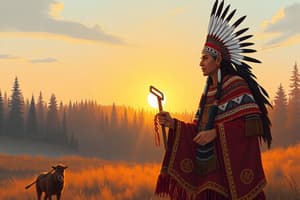Podcast
Questions and Answers
What does the term 'Anishinaabeg' mean in the Ojibwe language?
What does the term 'Anishinaabeg' mean in the Ojibwe language?
- Puckered People
- Warrior People
- Forest Dwellers
- True People (correct)
Which of the following resources was primarily gathered by Ojibwe women during the summer?
Which of the following resources was primarily gathered by Ojibwe women during the summer?
- Wild Rice
- Deer and Moose
- Maple Sap
- Berries and Nuts (correct)
From where did the Ojibwe, Ottawa, and Potawatomi tribes historically originate?
From where did the Ojibwe, Ottawa, and Potawatomi tribes historically originate?
- Mississippi River Valley
- Lake Michigan
- Great Plains
- Straits of Mackinac (correct)
What significant food source did the Ojibwe gather during the late summer and early fall?
What significant food source did the Ojibwe gather during the late summer and early fall?
What is the primary reason the Ojibwe practiced a semi-nomadic lifestyle?
What is the primary reason the Ojibwe practiced a semi-nomadic lifestyle?
What was primarily hunted by the Ojibwe during the winter months?
What was primarily hunted by the Ojibwe during the winter months?
Which of the following best describes the types of forests found in the Ojibwe territory?
Which of the following best describes the types of forests found in the Ojibwe territory?
What was the primary purpose of the sugar camps in spring for the Ojibwe?
What was the primary purpose of the sugar camps in spring for the Ojibwe?
What is the primary purpose of summer villages for the Ojibwe people?
What is the primary purpose of summer villages for the Ojibwe people?
What type of structure did Ojibwe men build while hunting away from their village?
What type of structure did Ojibwe men build while hunting away from their village?
How were the bands of Ojibwe people typically organized?
How were the bands of Ojibwe people typically organized?
What is a notable characteristic of the Ojibwe kinship system?
What is a notable characteristic of the Ojibwe kinship system?
What role did mothers' brothers play in the lives of Ojibwe boys?
What role did mothers' brothers play in the lives of Ojibwe boys?
Which term best describes the relationship between cross-cousins in Ojibwe culture?
Which term best describes the relationship between cross-cousins in Ojibwe culture?
What were Ojibwe clans named after?
What were Ojibwe clans named after?
Flashcards are hidden until you start studying
Study Notes
Ojibwe Language and Identity
- Ojibwe speaks an Algonkian language, being the largest tribe north of Mexico.
- Historical territory primarily located in Canada north of Lakes Superior and Huron, now spread across Ontario to Montana.
- Oral traditions link Ojibwe, Ottawa, and Potawatomi tribes to a common origin near the Straits of Mackinac, indicating a shared ancestry.
- Self-identification as "Anishinaabeg," meaning "True People" or "Original People."
- The term "Ojibwe" or "Ojibwa" likely originates from their traditional moccasin design with a puckered seam.
Subsistence and Seasonal Activities
- The Ojibwe's environment is characterized by mixed conifer and deciduous forests, abundant lakes, and rivers.
- Survived harsh winters through extensive knowledge of forest resources and a semi-nomadic lifestyle.
- Year-round fishing adapts to seasonal changes, with specific practices for each season.
- Summer activities included gathering wild foods and planting small gardens (corn, beans, squash).
- Late summer to early fall marked the ricing season, crucial for winter food storage.
- Winter hunting involved deer, moose, fox, and bear, with deer being the primary source of food and materials.
- Spring saw the gathering of maple sap for sugar production, vital for flavoring throughout the year.
Settlement Patterns and Social Structure
- Housing consisted of dome-shaped wigwams made from poles and covered with woven mats or birchbark.
- Summer villages contained multiple wigwams, serving as bases for resource gathering within a 50-mile radius.
- Winter living arrangements were more dispersed, focusing on extensive hunting expeditions.
- Men constructed temporary peaked lodges while hunting, or rectangular structures in sugarbush areas for sap gathering.
- Families formed bands of 20 to 50 people, bonded by kinship and sometimes intermarriage, operating independently but interacting for trade and social occasions.
- Strong family ties existed, particularly between parents and children, and between children and grandparents.
- Brothers and sisters maintained respectful and potentially shy relationships until marriage; boys shared a special bond with maternal uncles.
- Cross-cousins viewed as potential marriage partners, encouraged playful teasing and flirting.
- Traditionally patrilineal, with distinct names for different kinship relations; individuals belong to their father's clan, often named after an animal or bird.
- Clans were exogamous, with marriage occurring outside the clan, ensuring varied lineage within familial structures.
Studying That Suits You
Use AI to generate personalized quizzes and flashcards to suit your learning preferences.




